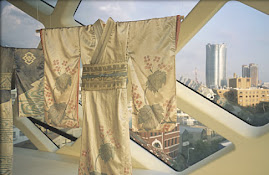 n though we all packed every minute full during our time in Japan, listening to others’ adventures reminded us that there was so much more to see. Today, back in Tokyo, we heard from the other nine groups who traveled to host cities all over Japan. Each group had different geographical and cultural experiences and there was some variation in the school visits. What seemed to be the same across the country was the children. It was so unifying to be reminded that kids are kids everywhere. Another thing we all shared is a renewed commitment to Peace and Environmental Education. I feel embarrassed when I think of how far behind our country is in making those two elements a priority. When Kejiro Matsushima first told us his story as a Hiroshima survivor days ago, he said, “You will tell your children what you learned in Japan and make some small waves.” We are ready to go home and do just that.
n though we all packed every minute full during our time in Japan, listening to others’ adventures reminded us that there was so much more to see. Today, back in Tokyo, we heard from the other nine groups who traveled to host cities all over Japan. Each group had different geographical and cultural experiences and there was some variation in the school visits. What seemed to be the same across the country was the children. It was so unifying to be reminded that kids are kids everywhere. Another thing we all shared is a renewed commitment to Peace and Environmental Education. I feel embarrassed when I think of how far behind our country is in making those two elements a priority. When Kejiro Matsushima first told us his story as a Hiroshima survivor days ago, he said, “You will tell your children what you learned in Japan and make some small waves.” We are ready to go home and do just that. 
Mostly, we’re ready to go home!
Fond Farewell
Tonight was th e last gathering of the last group of Japan Fulbright Memorial Fund teachers. There were speeches, an akito (sp?) demonstration, more great food, group snapshots, and tears. We've gotten really close and most of us won't see each other again. Singing "Auld Lang Syne" has never been so poignant.
e last gathering of the last group of Japan Fulbright Memorial Fund teachers. There were speeches, an akito (sp?) demonstration, more great food, group snapshots, and tears. We've gotten really close and most of us won't see each other again. Singing "Auld Lang Syne" has never been so poignant.
Tomorrow will be brutal. The group of us returning through Chicago don’t even leave the hotel until 2:00 p.m. We have nothing scheduled to do in the morning and have to be checked out by noon. It will be a day to hurry up and wait. We found out that tea ceremonies are performed in our hotel on Thursdays, so we may get to do one last cultural thing before we take off.
 e last gathering of the last group of Japan Fulbright Memorial Fund teachers. There were speeches, an akito (sp?) demonstration, more great food, group snapshots, and tears. We've gotten really close and most of us won't see each other again. Singing "Auld Lang Syne" has never been so poignant.
e last gathering of the last group of Japan Fulbright Memorial Fund teachers. There were speeches, an akito (sp?) demonstration, more great food, group snapshots, and tears. We've gotten really close and most of us won't see each other again. Singing "Auld Lang Syne" has never been so poignant.Tomorrow will be brutal. The group of us returning through Chicago don’t even leave the hotel until 2:00 p.m. We have nothing scheduled to do in the morning and have to be checked out by noon. It will be a day to hurry up and wait. We found out that tea ceremonies are performed in our hotel on Thursdays, so we may get to do one last cultural thing before we take off.
Our plane doesn’t leave until almost 6:00 p.m., then it’s 12 hours in the air until we land at Chicago. I, then, have a 3-hour layover until my plane to KC, and I still won’t be home. I may have one more blog entry after I get home and have time to reflect but no promises.
































 rigin was unclear, although we made a guess on everything.
rigin was unclear, although we made a guess on everything. g at all the shrines. There was soft-serve ice cream in the flavors you’d expect in addition to unexpected flavors such as bean curd, green tea, and plum. I tasted the green tea flavor, which was aptly named -- not a flavor I would associate with ice cream. Another fun thing I saw reminded me of the state fair. A man had a booth set up with bulls-eye targets where you could pay to try to shoot one with a bow and arrow. I saw a girl hit the target -- a lot of bells were rung, but I didn’t see her get a prize. The temple, shrines, and gardens were beautiful. Many people left money or burned incense in honor of ancestors.
g at all the shrines. There was soft-serve ice cream in the flavors you’d expect in addition to unexpected flavors such as bean curd, green tea, and plum. I tasted the green tea flavor, which was aptly named -- not a flavor I would associate with ice cream. Another fun thing I saw reminded me of the state fair. A man had a booth set up with bulls-eye targets where you could pay to try to shoot one with a bow and arrow. I saw a girl hit the target -- a lot of bells were rung, but I didn’t see her get a prize. The temple, shrines, and gardens were beautiful. Many people left money or burned incense in honor of ancestors.



